Author
Grace Yang
Abstract
Over the last decade, Asian Americans are the fastest growing ethnic group in the United States (Lam, 2016), and the visibility of Asian influence on popular culture has increased as well (Jin & Yoon, 2017). As a fast-growing minority community, the Asian community has been relatively overlooked in studies about attraction and the effects of ideals of masculinity. The aim of the current study was to investigate factors that influence the perception of the Asian and non-Asian faces with respect to attractiveness, dateability and masculinity. The current literature suggests that both Asian men and women are stereotyped to be relatively feminine (Wilkins et al, 2011; Mok, 1998), and thus would influence their ratings of attractiveness and dateability. If the idealized man is masculine, while the idealized woman is feminine (Little, Jones & DeBruine, 2011), then attractiveness ratings for Asian men would be low, while attractiveness ratings for Asian women would be high. Moreover, it was hypothesized that higher exposure to Asian media will increase ratings of attractiveness and dateability of Asian faces.
Results indicated that, sex and race of the photo had main effects on femininity, attractiveness, and dateability ratings. Dateability was found to be correlated to attractiveness ratings, but masculinity was not correlated to either. Exposure to Asian media did not significantly affect any ratings for male participants, but exposure to Asian media positively correlated with dateability ratings for female participants.
Femininity and Dateability: A Look at the Perception of Asian Faces
Recognizing faces is a skill essential to social cognition and communication. While infants can reliably detect faces as early as hours after birth (Farroni, Csibra, Simion, & Johnson, 2002; Farroni et al., 2005), face identification is not adult-like until early adolescence (De Sonneville et al., 2002; Diamond & Carey, 1977). Faces convey a wealth of information about general identity such as biological sex, race and age, but they are also judged for socially relevant information such as affect and attractiveness (Little, Jones & DeBruine, 2011). There seem to be general characteristics, such as symmetry and “averageness” that are related to high ratings of attractiveness, which is a component for mate and marriage choice (Nakamura, 2019).
Interestingly, the frequency of interracial marriages has been increasing in the United States (Livingston & Brown, 2019), but it is notable that marriages are asymmetrical with regards to race. For example, Asian women are more likely to marry White men than White women to Asian men (Fryer, 2007). Forty percent of Asian-American female newlyweds marry outside of their race, as do 20% of Asian-American males (Takinami, 2016). It is possible that this statistic might be linked to stereotyped notions of masculinity, which can affect ratings of attractiveness and dateability. The current study assessed whether there are differences in the attractiveness ratings of Asian and White faces. Because “averageness” depends on the individual’s schema of encountered faces, the current study also evaluated how Asian media exposure might have affected ratings of attractiveness, masculinity and dateability.
Face Recognition with a Cultural Lens: Attractiveness and Femininity
Studies on face recognition suggest that there are multiple characteristics that cue attractiveness (for review, see Little, Jones & DeBruine, 2011), such as symmetry and averageness. Secondary characteristics such as face shape and skin color and texture correlate with notions of femininity or health. However, faces of different races have different attributes, on average (e.g., chin width, skin tone), characteristics that may affect perception of attractiveness, dateability and masculinity.
Previous studies suggest that Asian faces as a group, regardless of biological sex, were judged as more feminine than masculine relative to a prototypical face. In addition, masculinity ratings were lower for faces in the experimental sample if they closely resembled the prototypical Asian face (Wilkins, Chan & Kaiser, 2011), a face with small eyes and fuller cheeks (Mok, 1999). In the study by Wilkins, Chan and Kaiser (2011), participants rated the femininity/masculinity of various racial groups on a Likert scale. The researchers found that Asians were rated as the least masculine racial group and the most feminine racial group. In other words, looking Asian was related to looking more feminine, which although likely beneficial for Asian women, could potentially be detrimental to the viewer perception of masculinity of Asian males.
Across several cultures, attractiveness of female faces has been linked to feminine features, such as large eyes and pronounced cheekbones (Johnston, 2006). However, the evidence that the attractiveness of male faces was linked to masculine features, was mixed (Scott et al, 2010). Nakamura and Watanabe (2019) mathematically modelled attractiveness ratings of Japanese observers, and found that larger eyes, brighter complexions and smaller noses were associated with femininity, youth and attractiveness in both male and female faces. This study implied that in (some) Asian cultures, faces with feminine traits are deemed attractive despite the biological sex of the image shown. It is unclear why there might be a difference in attractiveness ratings between Japanese and Western raters. However, this study examines the possibility that observers familiar with Japanese, or Asian faces in general, might rate Asian male faces more attractive or dateable compared to observers unfamiliar with Asian faces.
Media Portrayal of Asians in the United States
The media portrayal of Asians in the United States is limited, and is often stereotyped. Historically, Asians, primarily Chinese, played subservient roles such as passive servants, laundry men or prostitutes in movies. Due to the anti-Asian climate of the early 1900s, many Asian characters were portrayed as villains, culminating in an archetype evil genius known as “Fu Manchu”. Anna May Wong, a Chinese actor in the 1920s, was often cast as an evil seducer. Another way that Asians were depicted reflected the “model minority” narrative that all Asians were “overachievers who were intelligent, industrious, technologically savvy, mathematically talented, self-disciplined, self-sufficient, and law abiding” (Zhang, 2016). This was reflected in the Charlie Chan character popularized through radio, movies, television and comic strips (Corrigan, 2010). Early Hollywood portrayals of Asians may have set the stage on how Asian men and women are stereotyped today: Asian females are sex objects, and Asian males are quiet, passive and submissive (Chen, 1996).
Modern mainstream Western media has a significant lack of representation for Asian characters, with only 2.7% of characters being Asian in American media, despite 4.4% of the population being Asian or of Asian descent (Zhang, 2016). Many Asian characters in movies and television shows still reflect the model minority ideal, which does not match traditional notions of masculinity, and therefore, likely feminized the Asian population.
In recent years, media content has come to the United States from many Asian countries including China, Korea and Japan. Of note is the Korean Wave, or hallyu in Korean, an influx of Korean culture, and more broadly, Asian media, into Western Society beginning in 1997. As of 2014, export of Korean media alone was worth $4 billion American dollars (Jin & Yoon, 2017). This exposure to Asian media influences ideals about beauty and sexuality in Western cultures. However, there might be a reciprocity in influence. Asian media, specifically K-Pop groups, have been hypersexualized (Song, 2016). As sexual content grew in acceptance and popularity in Asian media, sexualization and objectification of Asians in the United States and in other western countries has also increased.
Notably male K-Pop groups have dominated the Korean Wave. In 2017, Time magazine selected K-pop band BTS as the most influential people on the Internet. What makes male K-Pop groups stand out is their display of flexible forms of masculinity, often showing colored hair, pastel and flowery clothing, as well as expressing cute gestures, such as blowing kisses. They also use hip hop imagery that is more in line with hegemonic masculinity. K-Pop uses a mixture of a soft aesthetic with harder, more masculine ideals. This mix of gender ideals caters to a younger audience, potentially influencing their perceptions of attractiveness and its relationship to masculinity.
Sex, Gender and Identity of Asians in the United States
The Gold Rush and railroad jobs of the 1800s in California and the Northwest region of the United States increased immigration of Chinese men, who wore traditional dresses and longer hair. On average, they also had slim builds and short statures. Chinese immigrants who stayed in the United States worked in the traditionally feminine sphere of laundry, cooks, and waiters, which contributed to the feminized notion of Asian men in American culture.
Interestingly, the occupations and activities of Chinese men were limited by legislation. Exclusionary laws pushed Chinese immigrants “into occupations devalued by Euro-American men”, they “became restricted to service positions such as cooks, waiters, dishwashers, and laundrymen”, and in fact at the turn of the 20th century, 25% of employed Chinese males were employed in the laundry industry (Chen, 1996, 64). Moreover, laws prohibited immigration of Asian females to the United States, citing them as potential sex workers for the White men in California and other areas out West while also prohibited interracial marriage to legitimize such relationships between Asian women and White men. This created a bachelor society where women were scarce and Asian men were forced to live alone or with other men. In this way, the sexuality of Asian men was reduced into a safe, eunuch-like existence, while the sexuality of Asian women was projected to be hyperactive and for the pleasure of white males. The feminization of Asian men has affected their ability to date and marry outside of their race, as they are often seen as too feminine by heterosexual women and gay men (Takinami, 2016).
Following World War II, between 1950 and 1964, 80% of Japanese, as well as 40% of Korean immigrants and all 16,00 Filipina immigrants, who entered the U.S. were “war brides”, women who were married to military personnel in a time of war. The ideal “war bride” was someone who was “naturally compliant and sexually erotic spouses who embodied the ideal of good wifely behavior and femininity” (Takinami, 2016, ). In many respects relative to wives from the West, Asian “war brides” were idealized domestic partners, in that they were perceived to be innately more feminine, more devoted and more dependent on their husbands. This perception of Asian immigrants has affected the stereotypes held about them even into modern society.
The pervasive stereotypes of Asians affect the self-concepts of many Asian Americans. In one survey study of Asian immigrants, the majority of female participants in the study found that they felt that their expression of gender in ethnic Asian settings as “performative” and felt more “normal” when their behavior was more congruent with mainstream white feminine ideals. The female participants also expressed that in some relationships with white individuals, cultural expectations of submissive or subservient behavior carried over and influenced the relationship dynamics (Pyke and Johnson, 2003). These participants felt that they often have to “prove” that they are outside of the stereotype of being quiet and subservient in order to fit in with the white culture around them. Thus, they felt like their behavior must be forced to be more opinionated or expressive in order to counteract stereotypes of Asians.
These stereotypes continue in affecting the dating and marriages of Asian individuals. While population diversity and shifting attitudes contribute to the increase of interracial dating and marriage and 39% of Americans said interracial marriage is good for society, Asian males are able to marry others of a different race at far smaller rates than Asian women (Livingston, 2017). In newlyweds, the rate of interracial marriage in Asian women is twice that of Asian men (Livingston, 2019). Attractiveness and proximity were significant predictors of interracial marriage and dating (Fujino, 1997). However, stereotyped notions of masculinity can affect ratings of attractiveness and dateability, which could explain the unevenness in the rate of interracial marriage in Asian men and women, as Asian men could be perceived as more feminine due to the reasons above and therefore not considered eligible partners.
The Current Study
This thesis is a replication and extension of prior studies that found that Asian men and women were perceived as more feminine than their European counterparts (Wilkins, Chan & Kaiser, 2011). There were three main analyses: (1) It was assessed how sexual dimorphism ratings (i.e., femininity and masculinity) were affected by race and biological sex. If results show that Asian men and women were rated more feminine than European men and women, then it would suggest that participants were likely using a prototype (i.e. stereotyped) image of racial categories of faces. (2) It was also assessed whether perceptions of sexual dimorphism affected dateability and attractiveness ratings of faces. If participants’ ratings of dateability and attractiveness were still correlated even if masculinity ratings were controlled, then it would suggest that attractiveness depended on factors other than dimorphic cues. (3) Moreover, the study evaluated if Asian media exposure modulated ratings of attractiveness and dateability. If this were the case, then this would indicate that media exposure can influence the relationship between gender expectation and attractiveness.
METHOD
Participants
Participants were gathered from the University of South Carolina and were recruited through links to the anonymous Qualtrics survey through the SONA System of the university. Participants were free to withdraw consent and discontinue participation in the study at any time without negative consequences. Informed consent was obtained from all participants prior to starting the survey.
One hundred and eighteen participants completed the survey (mean age = 21 years). Five participants marked their gender as nonbinary and therefore their answers were excluded from the data, making the total participants whose answers were considered 113. Ninety-two of the participants were female, twenty-one were male. The majority of participants were heterosexual, with 8 females reporting to be bisexual, four homosexual, two pansexual and one declined to disclose. 3 males reported being homosexual. The study was primarily driven by data from white heterosexuals.
Materials and Procedure
Forty faces were chosen from the Chicago Face Database (Ma et al, 2015). Every image contained a face with a neutral expression, background and attire. The pictures selected included 10 Asian males, 10 Asian females, 10 White females, and 10 White males, which were about 20 years of age.
A survey was designed using Qualtrics (Smith et al, 2020). Uncropped, color pictures were presented one image at a time in random order along with questions to rate attractiveness, dateability, and masculinity of faces from 1 to 10, with 1 being “Not at all” and 10 being “Extremely” (Figure 1). Data about the participant demographics: race and ethnicity, age, sex and sexual preference were also collected. ANOVAs and multiple regressions were conducted using SPSS (IBM Corp, 2017). Participants were also asked to rank their exposure to different kinds of Asian media from 1 to 10, with 1 being not at all familiar and 10 being extremely familiar.
Results and Discussion
There were three main analyses that were conducted. Firstly, a three-way mixed-measures ANOVA was carried out on each of the ratings of masculinity, attractiveness, and dateability in order to determine whether race and sex of the faces as well as the sex of the participants affected these ratings. Secondly, partial correlations showed that the relationships between dateabilty and attractiveness were significant but that masculinity relationship with each was a not significant factor. This suggests that attractiveness’ influence over dateability was based on factors, other than masculinity, like facial symmetry or “averageness”. Lastly, correlations between media exposure and masculinity, dateability and attractiveness were not significant, indicating that the amount and type of media consumed by the participant did not affect their ratings of dateability, attractiveness, or masculinity for any of the sample images.
Comparisons across Race and Sex
In order to evaluate whether masculinity, attractiveness and dateability ratings varied with race and sex of the faces in the images as well as with sex of the participants, we conducted separate 2 (race of picture) x 2 (sex of picture) x 2 (sex of participant), 3-way mixed-measures ANOVAs on our ratings.
Femininity and Masculinity
Results showed that there were significant main effects of sex of the picture, F (1, 113) = 177.400, p <0.001 with males being rated as more masculine than females, and race of picture, F (1, 113) = 27.055, p <0.001 with images of White individuals being rated as more masculine than images of Asian individuals. There was no significant interaction between the two factors, F (1, 113) = 0.192, p =0.663. Masculinity ratings were lower for Asian females (M = 2.798; SD =1.56) and males (M = 6.99; SD = 2.09 ) relative to White females (M = 3.21; SD =1.41 ) and males (M = 7.20; SD = 1.95). These results were consistent with previous data (Wilkins, et al, 2011) showing that Asian faces were perceived as more feminine than European faces. There were no significant effects associated with the sex of the participants (p-values >0.05), suggesting that ratings of masculinity were consistent across all participants, regardless of their own biological sex. (Figure 2).
Attractiveness
Results showed that there was a significant main effect of the sex of the individual in the picture, F (1, 112) = 102.432, p <0.001 with females being rated as more attractive than males, and a main effect of the race of the individual in the picture, F (1, 112) = 7.085, p =0.009 on attractiveness ratings with whites being rated as more attractive than Asians. There was a marginal interaction between the two factors, F (1, 112) = 5.277, p = 0.023. Attractiveness ratings were higher for Asian females (M = 4.24; SD =1.88) relative to White females (M = 4.17; SD =1.76), but lower for Asian males (M = 3.06; SD = 1.68) relative to White males (M = 3.50; SD = 1.65). Together with results from masculinity ratings, these data imply that ratings of attractiveness might be dependent on phenotypic prototypes of masculine and feminine traits. The attractiveness of sexually dimorphic faces may cue characteristics important in mate choice such as health or dominance. (See Rhodes, 2006, for review.) There were no significant effects associated with the sex of the participants (p-values >0.05), suggesting that ratings of attractiveness were consistent across all participants, regardless of their own biological sex. (Figure 3).
Dateability
Results showed that there was a significant main effect of sex of the picture, F (1, 113) = 12.686, p <.001, and a main effect of race of picture, F (1, 113) = 7.787, p=0.006, on dateability ratings. There was not a significant interaction between the two factors, F (1, 113) = 0.208, p =0.649, which is indicates that Asian men (M = 1.71; SD =1.05) were not seen as significantly less dateable than White men (M = 2.05; SD =1.17). The data between Asian women (M = 1.73; SD =1.37) and White women (M = 1.74; SD =1.34) show no difference. There was also a significant interaction associated with the sex of the participants and the sex of the picture, F (1, 39) = 22.229, p <0.0001. A main effect was also found between race, sex and the sex of the participant, F (1, 112) = 33.411, p<.001. These results indicate that dateability ratings were driven by the sexual preference of the participants. (Figure 4).
Correlations: Effect of Masculinity and Media Exposure
Pearson correlational (zeroth order) analyses were conducted on masculinity, attractiveness and dateability in order to evaluate whether these factors were linked. In addition, first order partial correlations were conducted on dateability and attractiveness, while controlling for masculinity ratings in order to evaluate whether or not judgement about sexual dimorphism affected the relationship between dateability and attractiveness. This is because attractiveness was found to predict dateability (Fujino, 1997), and it was linked to femininity or masculinity (Wilkins et al, 2011). Independent analyses were carried out based on the sex of the participants as dateability ratings were dependent on the sex of the participants.
Dateability was found to be generally linked to attractiveness, but masculinity ratings were not consistently related to attractiveness. In both male and female participants, the data suggest that the relationship between attractiveness and dateability cannot solely be explained by masculinity ratings.
Ratings of Female and Male Participants
For female participants, dateability for Asian females was significantly positively correlated with attractiveness, r ()= +0.398, p<0.001. Attractiveness scores were positive correlated with average exposure to Asian media, r()=+0.489, p<0.001, and with exposure to European media, r()=+0.308, p=0.03. Dateability was also positively correlated with Asian media exposure, r()=+0.620, p<0.001. Femininity was not significantly correlated with attractiveness, dateability, Asian or European media exposure.
For male participants, dateability for Asian females was significantly positively correlated with attractiveness, r()= +0.681, p<.001. Femininity and attractiveness were not significantly correlated and neither was femininity and dateability. Femininity was not significantly correlated with Asian or European media exposure.
Putting It All Together
Asian females were rated as the most attractive, and Asian males the least, though this difference was not statistically significant. Asian females were statistically the most dateable for male participants, and white males for female participants.
The correlations indicate that attractiveness is correlated with dateability, but not with ratings of masculinity, as shown in the partial correlations. Attractiveness and dateability could be determined as a result of other metrics, both perceptual and cultural that were used by participants in determining their attraction to and the dateability of the faces. Perceptually, studies have shown that individuals are attracted to symmetrical faces that are average, as well as facial cues that have been linked to personality (Little et al, 2011).
This could indicate that individuals determined attractiveness and dateability at least partially by perceptual judgements of personality, with more feminine features being valued by those looking for someone who values cooperation and sensitivity (Little et al, 2011). It has also been found that face shape and symmetry contribute to attractiveness ratings in perceptual judgement (Nakamura, 2019). Relative comparable facial symmetry in White and Asian faces could explain why they were not significantly different in attractiveness ratings.
Youthfulness is another potential factor in attractiveness ratings (Little et al, 2011). Youthfulness is a strong component in the appeal of K-Pop, which has developed significant social influence. It could be that due to the cultural influence of things like K-Pop where a youthful, flexible masculinity is portrayed, attractiveness becomes more tied to the youth than the masculinity. Expanding research could examine the influence of perceptions of youth on attractiveness and masculinity, particularly in Asian populations.
It could also be that societal stereotypes affect the way that Asian faces are perceived, but that this perception does not affect how attractive or dateable the faces are to the participant. With acceptance of interracial marriage increasing, it could be that there is less societal pressure to marry or date an individual of one’s own race (Livingston, 2019).
Dateability ratings were also found to not be significantly different in White and Asian faces. This could potentially be a result of the duration of dating not being defined, as studies have indicated that generally more masculine faces are preferred for short term relationships while more feminine faces are preferred when considering long term relationships (Nakamura, 2019).
It is also notable in this study that the sex of the images shown did not affect female participants ratings of dateability significantly, though the study was largely driven by heterosexual participants. One explanation for this could be a misunderstanding of the question for dateability as asking if the person was generally dateable instead of it being a personal decision to date them. Another explanation is that women took into account factors like general dateability or likeability into effect when rating the dateability of same-sex images, which is supported by a study which found that “attractiveness judgements of the other-sex faces are more likely to include an evaluation of desirability to the judge as a sexual or romantic sexual partner, while judgements of same-sex faces are more likely to be evaluated on imagined desirability to other-sex people or on non-sexual, general positive regard, such as likeability” (DeBruine, 2014, 2086). In short, it seems that female participants looked at how dateable an individual might be overall, while male participants interpreted the question as how dateable the image was to them personally.
It is also important to remember that the Chicago Face Database consists of pictures of real individuals. Variability between the facial expressions and background are as controlled as possible but ethnicity of the pictures used were not specified any more than “White” and “Asian” labels. It could be that the differences in ethnic features between groups under the White and Asian labels could affect ratings and is an area for further study.
A larger sample size including more diversity in gender identity and sexual orientations could more effectively look at the results of other sexualities and how sexuality of the participant affected the value of masculinity in their judgments of attractiveness and dateability. It could be that as society moves away from the gender binary, traditional ideas of masculinity and masculine features are beginning to become less attractive or feminine features are becoming equally as attractive. Future studies should be done to determine more clearly the relationship between dimorphism, attractiveness, and dateability. Studies could be done as well to look more closely at the type of media consumed by the participant and how that affects their ideas of dimorphism and attractiveness.
About the Author
 Grace Yang
Grace Yang
My name is Grace Yang and I graduated from UofSC in August of 2020. I majored in Experimental Psychology and was a member of the Honors College. I am currently a graduate student in the school of Social Work here at UofSC, graduating in Spring of 2022. I would like to concentrate in Health and Mental Health and work with homeless populations with mental illness.
I was inspired to begin this project by my own Asian heritage and the interest I had in how attractiveness is perceived. I wrote this paper as my honors thesis under the guidance of Dr. Melanie Palomares and our lab team, Cameron Morrison, Sung Kim, and Kayli Carmon, without whose guidance and advice I could not have thoroughly fleshed out the idea and research analysis.
Bibliography
Chen, C. H. (1996). Feminization of Asian (American) men in U.S. mass media. Journal of Communication Inquiry, 20, 57-71.
Corrigan, M. (2010). Giving ‘Charlie Chan’ a second chance. Retrieved from https://www.npr.org/templates/story/story.php?storyId=129260913
De Sonneville, L.M., Verschoor, C.A., Njiokiktjien, C., Op het Veld, V., Toorenaar, N., & Vranken, M. (2002). Facial identity and facial emotions: speed, accuracy, and processing strategies in children and adults. Journal of Clinical and Experimental Neuropsychology, 24, 200-213.
DeBruine, L.M. (2004) Facial resemblance increases the attractiveness of same-sex faces more than other- sex faces. Proceedings: Biological Sciences, 271, 2085-2090.
Diamond, R., & Carey, S. (1977). From piecemeal to configurational representation of faces. Science, 195, 312–314.
Farroni, T., Csibra, G., Simion, F., & Johnson, M.H. (2002). Eye contact detection in humans from birth. Proceedings of the National Academy of Sciences of The United States, 99, 9602- 9605.
Farroni, T., Johnson, M.H., Menon, E., Zulian, L., Faraguna, D., & Csibra, G. (2005). Newborns preference for face relevant stimuli: Effects of contrast polarity. Proceedings of the National Academy of Sciences of The United States, 102, 17245-17250.
Fryer, R. (2007). Guess who’s been coming to dinner?: trends in interracial marriage over the 20th century. Journal of Economic Perspectives, 21, 71-90.
Fujino, D. C. (1997). The rates, patterns and reasons for forming heterosexual interracial dating relationships among asian americans. Journal of Social and Personal Relationships, 6, 809-828.
Han, C. (2006). Being an Oriental, I could never be completely a man: Gay Asian men and the intersection of race, gender, sexuality, and class. Race, Gender & Class, 13, 82-97.
IBM Corp. Released 2017. IBM SPSS Statistics for Windows, Version 25.0. Armonk, NY: IBM Corp.
Jin, D. Y., & Yoon, T.-J. (2017). The korean wave: retrospect and prospect. International Journal of Communication, 11, 2241–2249.
Johnston, V. S. (2006). Mate choice decisions: the role of facial beauty. Trends in Cognitive Sciences, 10, 13.
Lam, C. (2016). Asians remain fastest-growing US group as Pacific Islanders, Mixed-Race numbers grow: Census, NBC News. Retrieved from: https://www.nbcnews.com/news/asian-america/ asians-remain-fastest-growing-us-group-pacific-islanders-mixed-race-n597711
Little, A.C. et al (2011). Facial attractiveness: evolutionary based research. Philosophical Transactions of the Royal Society B: Biological Sciences, 366, 1638-1659.
Livingston, G., & Brown, A. (2017, May 18). 2. Public views on intermarriage. Retrieved May 22, 2020, from https://www.pewsocialtrends.org/2017/05/18/ 2-public-views-on-intermarriage/
Livingston, G., & Brown, A. (2019, December 31). 1. Trends and patterns in intermarriage. Retrieved May 22, 2020, from https://www.pewsocialtrends.org/2017/05/18/ 1-trends-and-patterns-in-intermarriage/
Ma, D., Correll, J., & Wittenbrink, B. (2015). Chicago Face Database. The University of Chicago.
Mok, T. A. (1999). Asian American dating: Important factors in partner choice. Cultural Diversity and Ethnic Minority Psychology, 5, 103–117.
Nakamura, K. & Watanabe, K. (2019). Data-driven mathematical model of East-Asian facial attractiveness: the relative contributions of shape and reflectance to attractiveness judgements. Royal Society Open Science, 6.
O’Toole, A.J., Deffenbacher, K.A., Valentin, D., McKee, K., Huff, D., Abdi, H. (1998). The perception of face gender: The role of stimulus structure in recognition and classification. Memory & Cognition. 26:146–160. [PubMed] [Google Scholar]
Pyke, K. D., & D. L. Johnson (2003). Asian American women and racialized femininities: “doing” gender across cultural worlds. Gender and Society, 17, 33-51.
Scott, I.M., Pound N, Stephen I.D., Clark A.P., & Penton-Voak, I.S. (2010). Does masculinity matter? The contribution of masculine face shape to male Attractiveness in humans. PLOS One, 5, 1-10.
Smith, S.M. (2020). Qualtrics XM. 2020 Qualtrics.
Song, B. (2016). Seeing is believing: content analysis of sexual content in korean music videos. (PDF) (Masters). Southern Utah University.
Takinami, E. P. (2016). Feminized Asians and masculinized Blacks: The construction of gendered races in the United States. (PDF) (Thesis). University of Vermont.
Wang, A. (2000). Asian and White Boys’ competing discourses about masculinity: implications for secondary education. Canadian Journal of Education, 25, 113-125.
Wilkins, C. et al (2011). Racial stereotypes and interracial attraction: phenotypic prototypicality and perceived attractiveness of Asians. Cultural Diversity and Ethnic Minority Psychology, 17, 427-431.
Zhang, Q.(2016) Asian Americans beyond the model minority stereotype: The nerdy and the left out. Journal of International and Intercultural Communication, 3, 20-37.
FIGURE 1
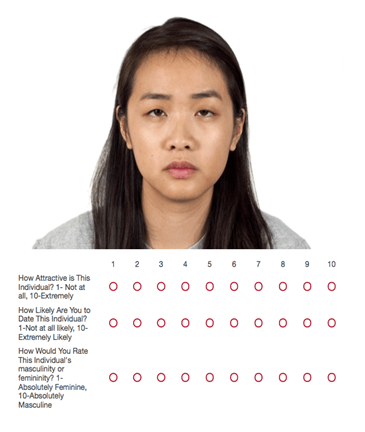
Figure 1: Example survey question.
FIGURE 2
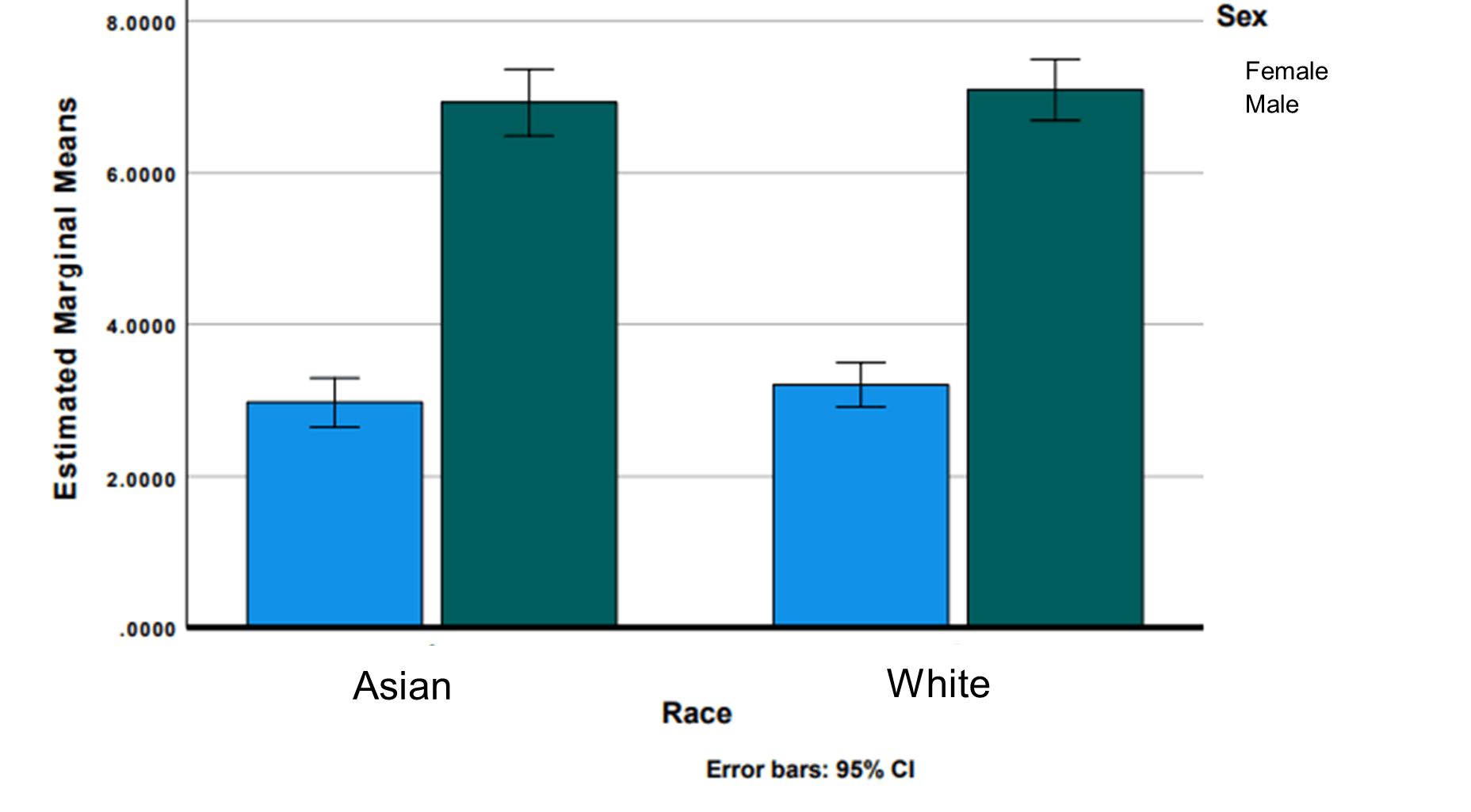
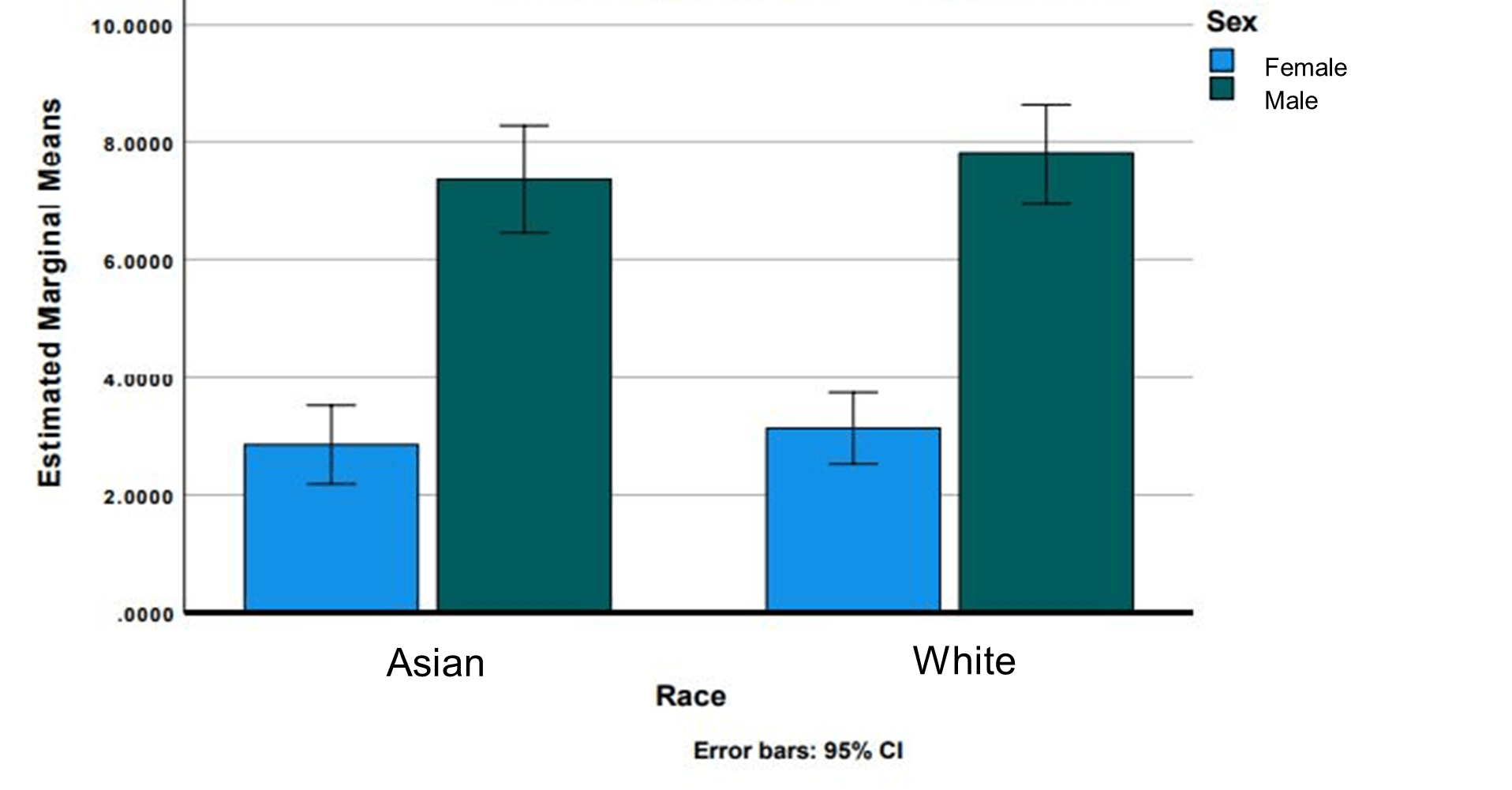
Figure 2. Masculinity ratings as a function of face category separated by the biological sex of the participants. Error bars +/- 1 SD.
FIGURE 3
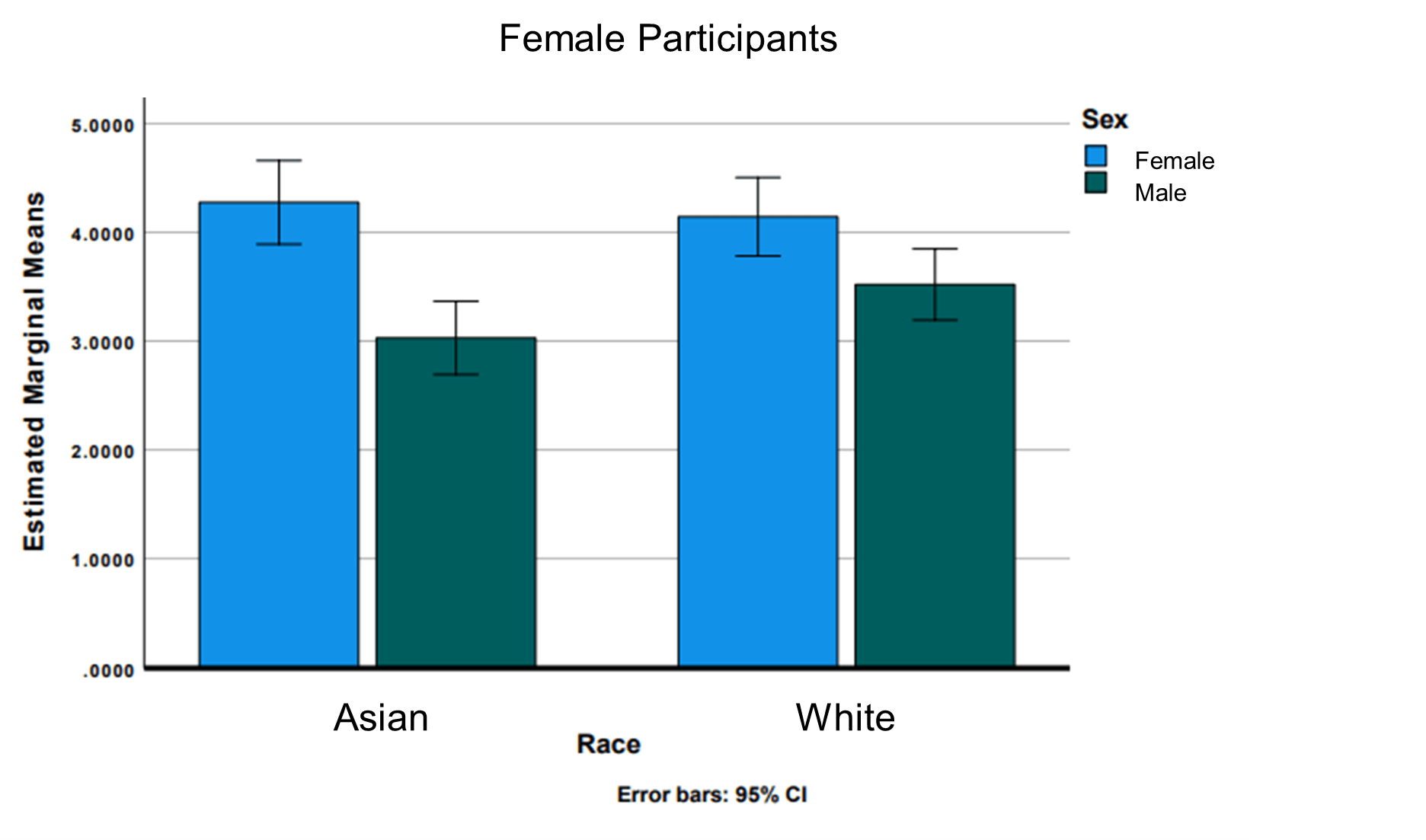
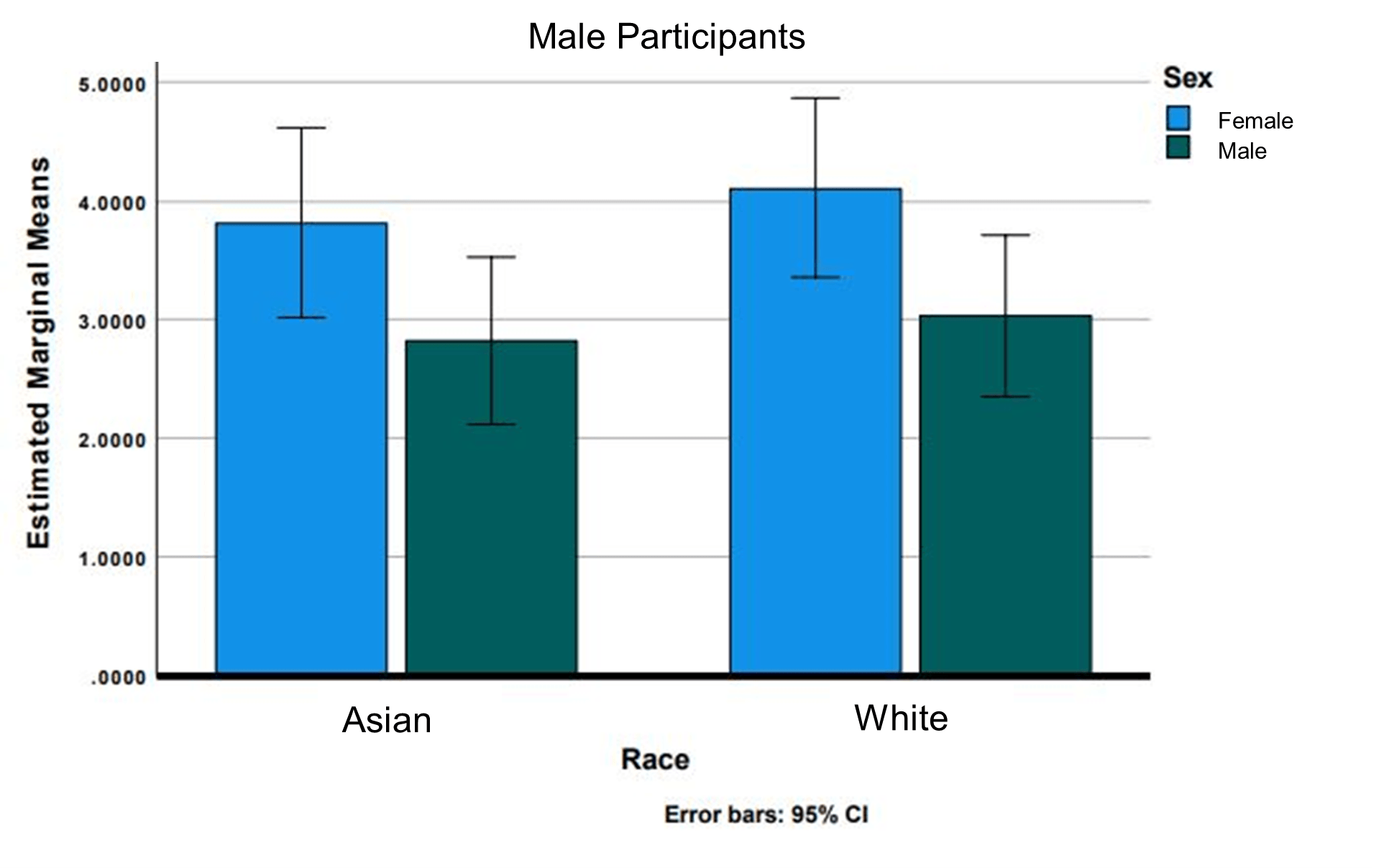
Figure 3. Attractiveness ratings as a function of face category separated by the biological sex of the participants. A for female participants, B for male participants. Error bars +/- 1 SD.
FIGURE 4
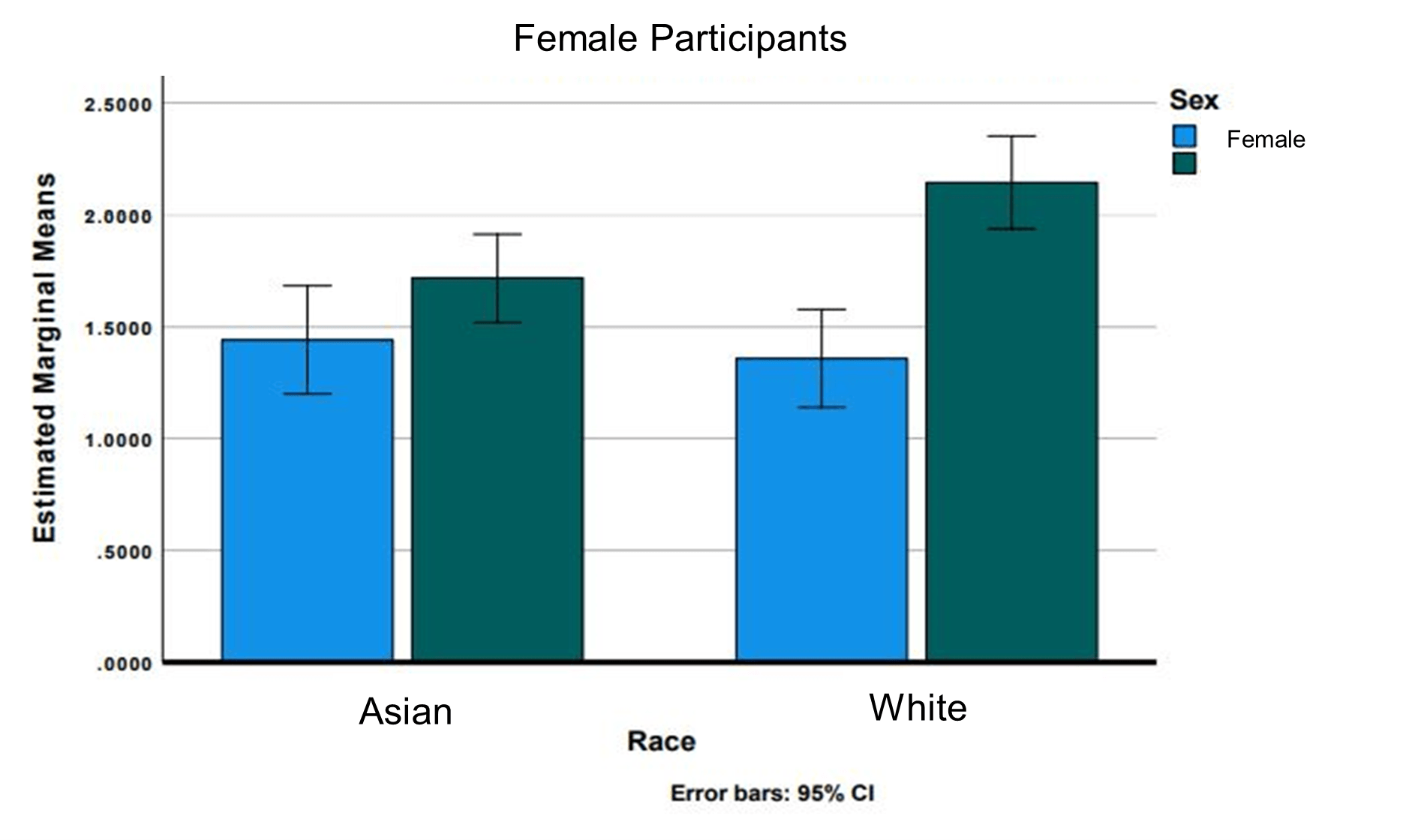
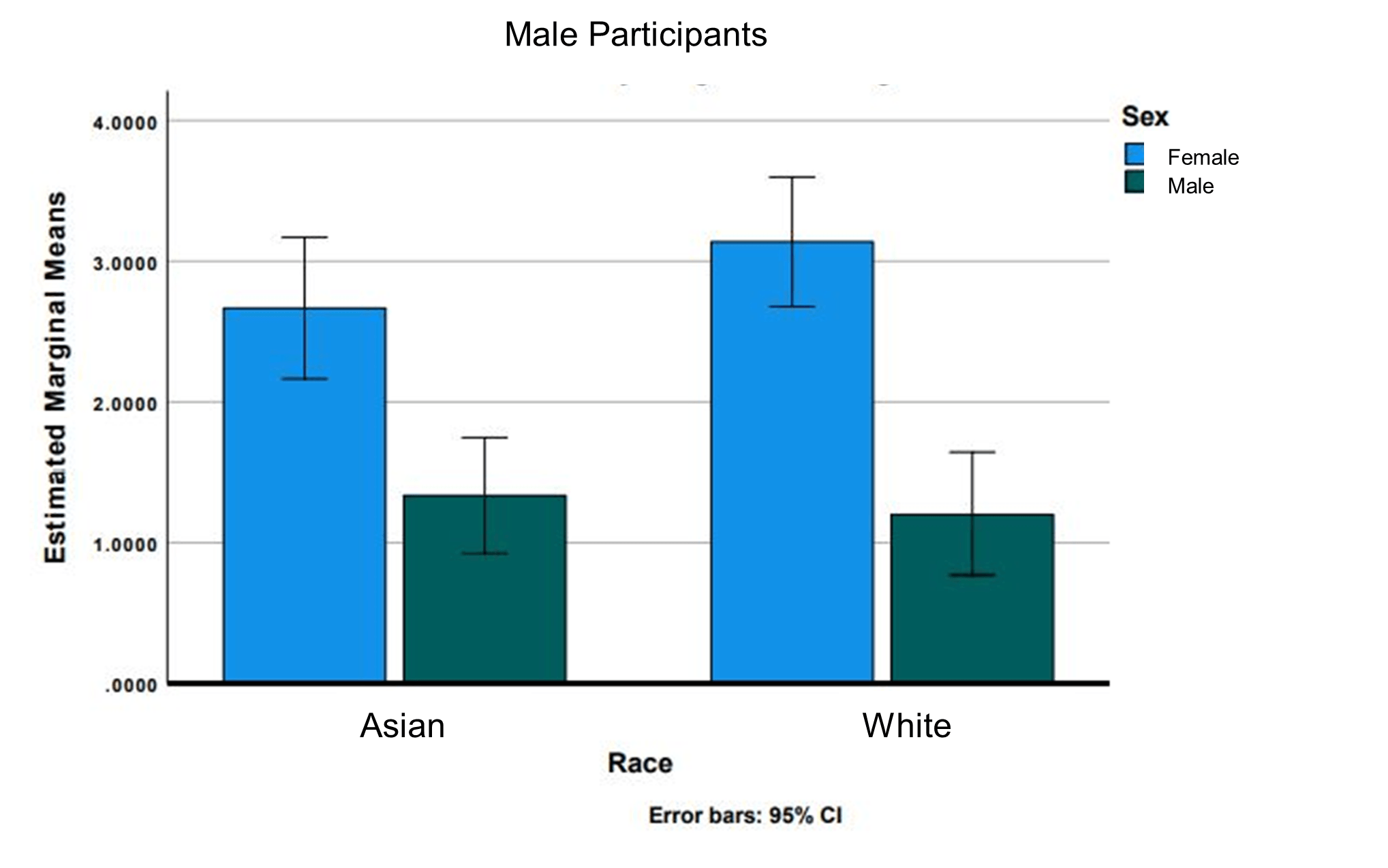
Figure 4. Dateability ratings as a function of face category separated by the biological sex of the participants. A for female participants, B for male participants. Error bars +/- 1 SD.
